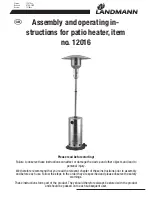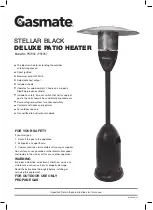
www.fmiproducts.com
125001-01B
19
Note: Pilot flame on natural gas units will have
a slight curve, but flame should be blue and
have no yellow or orange color.
BURNER PRIMARY AIR HOLES
Air is drawn into burner through holes in fit-
ting at entrance to burner. These holes may
become blocked with dust or lint. Periodically
inspect these holes for any blockage and
clean as necessary. Blocked air holes will
create soot.
INSPECTING bURNERS
Continued
MAIN BURNER
Periodically inspect all burner flame holes
with heater running. All slotted burner flame
holes should be open with yellow flame pres-
ent. All round burner flame holes should be
open with a small blue flame present. Some
burner flame holes may become blocked by
debris or rust, with no flame present. If so,
turn off heater and let cool. Remove blockage,
blocked burner flame holes will create soot.
Figure 23 - Orifice Holder On Outlet
Burner Tube
Burner Tube
Primary Air Inlet
Holes (Shape of
Holes May Vary
by Model)
Orifice Holder (May Be Brass or
Aluminum Depending on Model)
Figure 24 - Pilot Inlet Air Hole
Pilot
Assembly
Pilot Air Inlet Hole
CLEANING AND MAINTENANCE
WARNING: Turn off heater
and let cool before cleaning.
CAUTION: You must keep con-
trol areas, burner and circulating
air passageways of heater clean.
Inspect these areas of heater
before each use. Have heater
inspected yearly by a qualified
service person. Heater may need
more frequent cleaning due to
excessive lint from carpeting,
bedding material, pet hair, etc.
WARNING: Failure to keep
the primary air opening(s) of
the burner(s) clean may result in
sooting and property damage.
Once every year a qualified agency or certified
chimney sweep should examine and clean the
venting system of fireplace.
ODS/PILOT AND BURNER
Use a vacuum cleaner or small, soft bristled
brush to clean.
BURNER ORIFICE HOLDER AND
PILOT AIR INLET HOLE
The primary air inlet holes allow the proper
amount of air to mix with the gas. This pro-
vides a clean burning flame. Keep these holes
clear of dust, dirt and lint. Clean these air inlet
holes prior to each heating season. Blocked
air holes will create soot. We recommend that
you clean the unit every three months during
operation and have heater inspected yearly
by a qualified service person.
We also recommend that you keep burner tube
and pilot assembly clean and free of dust and
dirt. To clean these parts we recommend using
compressed air no greater than 30 PSI. Your
local computer store, hardware store or home
center may carry compressed air in a can. If
using compressed air in a can, please follow
directions on can. If you don’t follow directions
on can, you could damage pilot assembly.
1. Shut off unit, including pilot. Allow unit to
cool for at least thirty minutes.
2. Inspect burner, pilot and primary air inlet
holes on orifice holder for dust and dirt
(see Figure 23).
3. Blow air through ports/slots and holes in
burner.
4. Check orifice holder located at end of
burner tube again. Remove any large
particles of dust, dirt, lint or pet hair with
a soft cloth or vacuum cleaner nozzle.










































